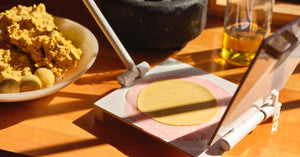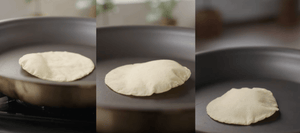How to Make Tortillas for Your Restaurant From Masa Harina
How to Make Tortillas for Your Restaurant From Masa Harina

April 1, 2025
For chefs and restaurant operators, tortillas aren’t just a vessel — they’re the backbone of a menu. Whether you’re running a taquería, a fine dining kitchen, or a high-volume operation, the right masa makes all the difference. We offer two chef-trusted options: Heirloom Corn Masa Harina and Masa Taquera. Each is designed for professional use, but they perform a little differently in the kitchen.
Below, we’ll break down the differences between the two, show you how to make tortillas in both small test batches and full-bag production runs, and answer common chef questions about cooking and storing tortillas for service.
Masa Taquera vs. Heirloom Masa Harina: What’s the Difference?
Heirloom Corn Masa Harina
- Corn: Single-origin heirloom corn grown by our farmer-partners in Mexico.
- Texture & Flavor: Fine-ground for pillowy and delicate table tortillas. Corn-forward flavor with tasting note nuances per varietal.
- Color: Available in four different colors: blue, white, yellow and red.
- Best For: Á la minute table tortillas, taco specials, unique masa shapes, or anywhere flavor and aesthetics are front and center.
Masa Taquera
- Corn: Non-GMO white corn nixtamalized in Mexico. (Though thanks to a high lime/cal content, this masa yields a more yellow tortilla.)
- Texture & Flavor: High-pH, nixtamal-forward flavor reminiscent of a tortillería.
- Performance: Added pericarp (corn skins) for extra pliability and durability. Tortillas bend without cracking or crumbling and can be held warm or reheated with ease.
- Best For: High-volume kitchens, delivery, and catering operations serving up tacos. This is a workhorse masa that holds up beautifully through service.

Small-Batch Masa Preparation
Heirloom Corn Masa Harina or Masa Taquera
1 cup masa harina (120 g)
1 scant cup warm water (7 fl oz or 200 g)
Optional: 1/2 tsp salt
Mix until evenly hydrated (about two minutes). Dough should feel like play-doh — not sticky, not crumbly.
Perform the Smush Test to ensure masa is well-hydrated: Roll a test ball (about 40 g) and smush it between thumb and forefingers. If the edges crack, your dough needs a bit more water. If it's sticking to your hand when smushed, you need a bit more masa harina. Adjust as needed.
Rest 5 minutes before pressing.
Yields: ~8 tortillas (about 5.5 inches)
Large-Batch Masa Preparation
Heirloom Masa Harina (50 lb bag)
For a 50 lb bag, begin by adding ~30 liters of warm water (about 8 gallons).
Mix 3–5 minutes in a commercial mixer, adjusting hydration as needed until the dough is smooth and pliable. Let rest 5–10 minutes.
Yields: ~54–55 kg hydrated masa (≈ 119–121 lbs)
Masa Taquera (44 lb bag)
For a 44 lb bag, begin by adding 27–28 liters of warm water (about 7 gallons).
Mix 3–5 minutes in a commercial mixer, adjusting hydration as needed until the dough is smooth and pliable. Let rest at least 5 minutes.
Yields: ~47–48 kg hydrated masa (≈103–105 lbs)
Cooking Tortillas
Roll masa into ping-pong-ball-sized balls (approx. 40 g each or 1 ounce for table tortillas), placing them back into the bowl or on a sheet tray once rolled. Cover with a damp dish towel.
Heat seasoned/non-stick Comal or flat top to medium-high heat (450–500°F).
Open tortilla press and place a thin sheet of plastic (aka a tortilla press liner) down. Place one ball of masa on the plastic, cover with a second sheet of plastic, and press down slightly to flatten, aiming for a 1/16" thick tortilla. Open press, removing the top sheet of plastic and placing the uncooked tortilla on your palm before removing the bottom piece.
Gently lay the tortilla on the hot Comal or pan in a backhanded motion, searing for 30 seconds on the first side. Flip the tortilla to allow the other side to sear for the same amount of time. One last flip to land back on the first side, which is where the tortilla will finish — this is where puff happens. Continue cooking all tortillas.
Stack tortillas in a tortillero or clean dish towel as soon as they come off the heat, which captures steam and increases pliability. Serve immediately or see storage tips below.
Storing Tortillas for Service
- On the Line: Keep cooked tortillas warm in a tortilla warmer or wrapped in a clean kitchen towel, in a hotel pan.
- For Later Service: Store in a sealed container at room temp for up to four hours. Reheat briefly on a hot comal.
- For Next-Day Service: Cool tortillas completely before stacking, wrapping tightly in plastic wrap, and refrigerating. Reheat on a hot surface or steam briefly to restore pliability.
- Freezing: Tortillas freeze well if cooled, stacked, and sealed airtight. Thaw before reheating on a hot comal.
Frequently Asked Questions
How do I keep tortillas from cracking?
Check hydration first. Add water gradually until masa feels pliable but not sticky. (See: Smush Test.) Masa Taquera is especially forgiving, thanks to its higher pericarp content.
Can I use a sheeter?
Yes. Both masas work in mechanical presses.
Should I add salt to my masa?
That’s up to you. Traditional corn tortilla recipes don’t call for salt, but we know lots of folks who have great success with bringing out the flavor of the corn with the right amount of salt. We recommend 1/2 to 1 tsp per cup of masa harina.
How do I get tortillas to puff?
Even hydration, proper compression, and a hot cooking surface are key. Check out our tips here. Masa Taquera lends itself well to consistent puffing.
How do I add flavor variations to my masa?
Chefs often incorporate herbs, spices, chiles, or infused oils into masa for signature tortillas. Just be mindful of hydration — adjust water slightly to account for additions.
Final Thoughts
Tortillas are deceptively simple — just corn and water, perhaps a bit of salt — but the details make the difference between average and unforgettable. And while we stand by our directions as written, we encourage anyone who makes tortillas to embrace the tactile nature of the craft and adjust the recipe based on environment and preferences. After all, the best tortillas aren’t measured by precision, but by feel — a reflection of the cook’s own hands and intuition. That’s the way it’s been done for centuries — so why not join the tradition?
As always, our hospitality team is here to help troubleshoot or act as a sounding board. Text us at 213-435-9037 or email us at orders [at] masienda.com.



